Intel 11th Generation Core Tiger Lake-H Performance Review: Fast and Power Hungry
by Brett Howse & Andrei Frumusanu on May 17, 2021 9:00 AM EST- Posted in
- CPUs
- Intel
- 10nm
- Willow Cove
- SuperFin
- 11th Gen
- Tiger Lake-H
CPU Tests: Encoding
One of the interesting elements on modern processors is encoding performance. This covers two main areas: encryption/decryption for secure data transfer, and video transcoding from one video format to another.
In the encrypt/decrypt scenario, how data is transferred and by what mechanism is pertinent to on-the-fly encryption of sensitive data - a process by which more modern devices are leaning to for software security.
Video transcoding as a tool to adjust the quality, file size and resolution of a video file has boomed in recent years, such as providing the optimum video for devices before consumption, or for game streamers who are wanting to upload the output from their video camera in real-time. As we move into live 3D video, this task will only get more strenuous, and it turns out that the performance of certain algorithms is a function of the input/output of the content.
HandBrake 1.32: Link
Video transcoding (both encode and decode) is a hot topic in performance metrics as more and more content is being created. First consideration is the standard in which the video is encoded, which can be lossless or lossy, trade performance for file-size, trade quality for file-size, or all of the above can increase encoding rates to help accelerate decoding rates. Alongside Google's favorite codecs, VP9 and AV1, there are others that are prominent: H264, the older codec, is practically everywhere and is designed to be optimized for 1080p video, and HEVC (or H.265) that is aimed to provide the same quality as H264 but at a lower file-size (or better quality for the same size). HEVC is important as 4K is streamed over the air, meaning less bits need to be transferred for the same quality content. There are other codecs coming to market designed for specific use cases all the time.
Handbrake is a favored tool for transcoding, with the later versions using copious amounts of newer APIs to take advantage of co-processors, like GPUs. It is available on Windows via an interface or can be accessed through the command-line, with the latter making our testing easier, with a redirection operator for the console output.
We take the compiled version of this 16-minute YouTube video about Russian CPUs at 1080p30 h264 and convert into three different files: (1) 480p30 ‘Discord’, (2) 720p30 ‘YouTube’, and (3) 4K60 HEVC.
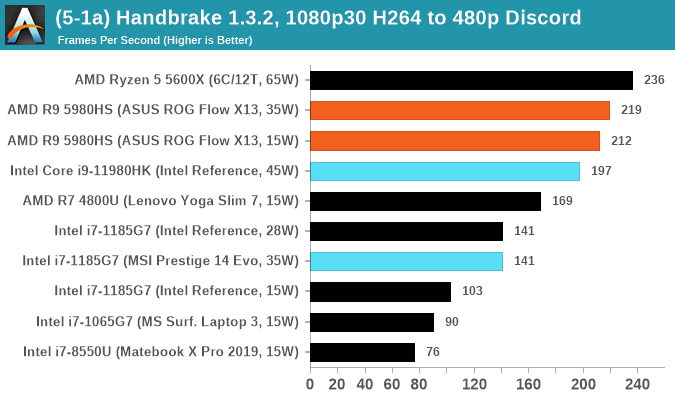
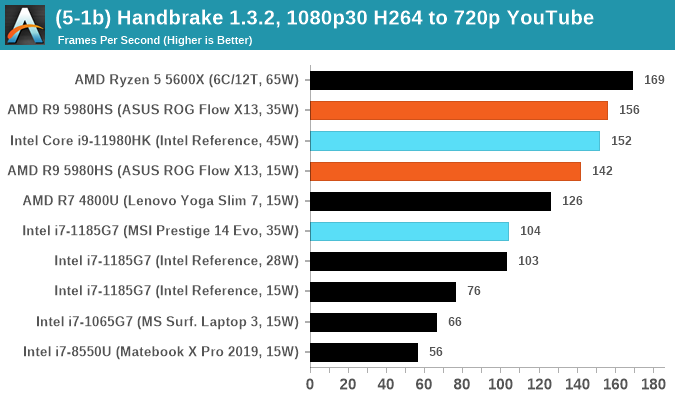
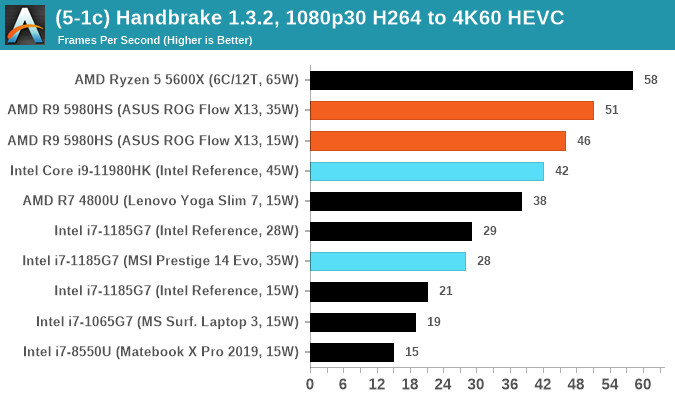
Threads wins, although the +30W difference to the desktop processor with two fewer cores can't be overhauled. Almost though.
7-Zip 1900: Link
The first compression benchmark tool we use is the open-source 7-zip, which typically offers good scaling across multiple cores. 7-zip is the compression tool most cited by readers as one they would rather see benchmarks on, and the program includes a built-in benchmark tool for both compression and decompression.
The tool can either be run from inside the software or through the command line. We take the latter route as it is easier to automate, obtain results, and put through our process. The command line flags available offer an option for repeated runs, and the output provides the average automatically through the console. We direct this output into a text file and regex the required values for compression, decompression, and a combined score.
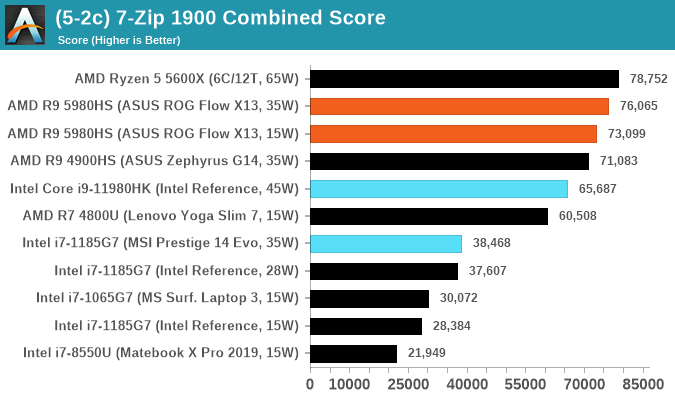
AES Encoding
Algorithms using AES coding have spread far and wide as a ubiquitous tool for encryption. Again, this is another CPU limited test, and modern CPUs have special AES pathways to accelerate their performance. We often see scaling in both frequency and cores with this benchmark. We use the latest version of TrueCrypt and run its benchmark mode over 1GB of in-DRAM data. Results shown are the GB/s average of encryption and decryption.

WinRAR 5.90: Link
For the 2020 test suite, we move to the latest version of WinRAR in our compression test. WinRAR in some quarters is more user friendly that 7-Zip, hence its inclusion. Rather than use a benchmark mode as we did with 7-Zip, here we take a set of files representative of a generic stack
- 33 video files , each 30 seconds, in 1.37 GB,
- 2834 smaller website files in 370 folders in 150 MB,
- 100 Beat Saber music tracks and input files, for 451 MB
This is a mixture of compressible and incompressible formats. The results shown are the time taken to encode the file. Due to DRAM caching, we run the test for 20 minutes times and take the average of the last five runs when the benchmark is in a steady state.
For automation, we use AHK’s internal timing tools from initiating the workload until the window closes signifying the end. This means the results are contained within AHK, with an average of the last 5 results being easy enough to calculate.
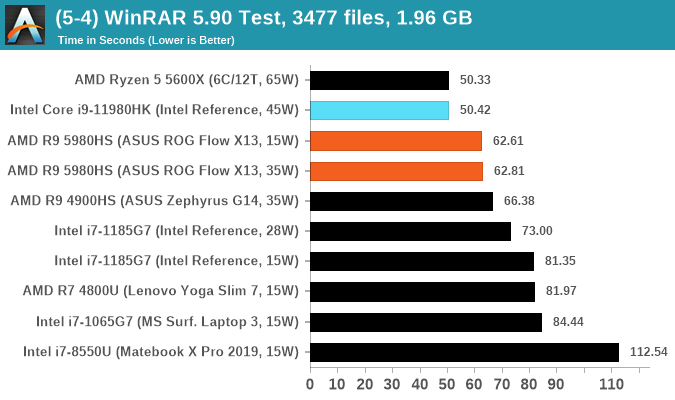


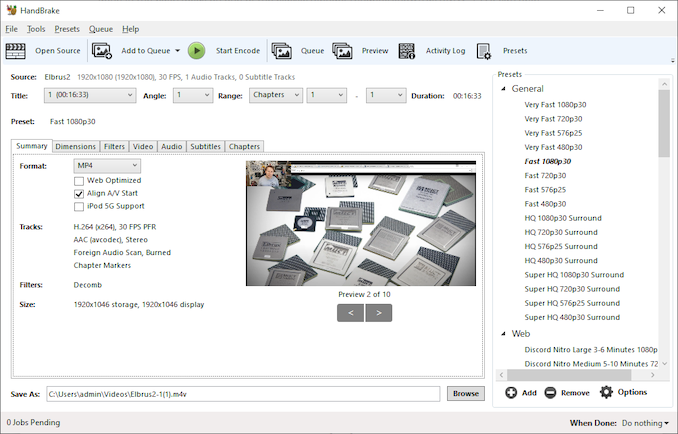
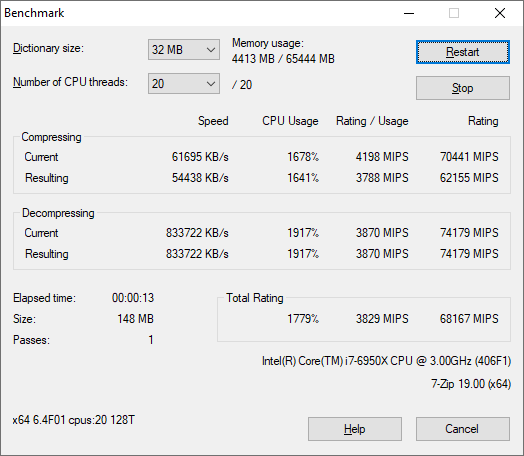









229 Comments
View All Comments
eastcoast_pete - Monday, May 17, 2021 - link
A key question is now if Intel can further improve its 10 nm superfin process in time for Alder Lake. This TL is at least getting somewhat close to AMD's monolithic Zen3, but Rembrandt is around the corner, and that'll be an even more capable competitor. Right now, Intel retains its market share mostly because AMD can't deliver as many CPUs as people would buy.hfm - Monday, May 17, 2021 - link
I'm looking forward to an i5 or i7 design with no dGPU and that sweet embedded TB4. Probably going to be a small subset of the offerings like the lower tier XPS 15/17. Interested to see what comes about later in summer.evilspoons - Monday, May 17, 2021 - link
It'd be helpful to see power-normalized graphs, some of these results are a bit of a double-edged sword.outsideloop - Monday, May 17, 2021 - link
I want to see a comparison of the 11980HK with the 5800X clocked down to 65W, apples to apples. Let's compare the thermals of the AMD 8-core desktop to this "desktop replacement" Intel 8-core.Hifihedgehog - Monday, May 17, 2021 - link
Core i9-11980HK:https://images.anandtech.com/doci/16680/P95-45W_57...
Ryzen 9 5980HK:
https://images.anandtech.com/doci/16446/Power-P95-...
Just to add some further insight on these two charts, here is some breakdown. What ultimately happens is under sustained heavy loads, Ryzen 5000 series can maintain 8 cores at higher sustained clock speeds (~3.7 GHz) with lower power draw (35W). Bear in mind also that Zen 3 has a slight IPC advantage over Tiger Lake, meaning at a lower clock speed, it performs the same or does the same amount of work as Tiger Lake at a higher clock speed. Yet here we are where Ryzen 5000 can clock higher, do even MORE work, and draw less power. Meanwhile, Intel is struggling to reach similar sustained clock speeds (~3.2 GHz) at 45W sustained and it has slightly lower IPC. That is, Ryzen 5000 is ~10% faster clock-for-clock (or in IPC) than Intel's Willow Cove (Tiger Lake 11th Gen), Cypress Cove (Rocket Lake 11th Gen) or Sunny Cove (Ice Lake 10th Gen) which all three share roughly the same IPC amongst the whole trio (link: https://www.guru3d.com/articles_pages/intel_core_i... ). Ryzen 5000's synergy (higher clocks, lower power, higher IPC) sounds like a recipe for disaster for Intel, no? Alder Lake needs to come sooner rather than later if you ask me. Let's just hope Intel is throwing the full weight of their massive workforce of software developers at the problem of Alder Lake's heterogenous architecture because they will certainly need it working smoothly for it to shine.
lmcd - Monday, May 17, 2021 - link
Can we pause to note that MSI delivering bad thermal performance is characteristic of every single one of their laptops, bar none?lmcd - Monday, May 17, 2021 - link
Like, obviously that doesn't solve all the problems here, but how on earth with all the delays TGL-H(45+) got is this the OEM Intel picked?Spunjji - Tuesday, May 18, 2021 - link
It's a very odd choice. But then, didn't they use MSI for the original TGL reference platform too? That one actually outperformed most shipping devices, although IIRC it did so by running the fans at 100% 🤷♂️lmcd - Tuesday, May 18, 2021 - link
I put it on twitter also but my opinion is that the Tiger Lake MSI design is actually about the cooling and size that MSI would use for an H series processor normally, such as the MSI Creator.This implies that the MSI's thermal overhead is pure luck on Intel's part in that MSI didn't have time to reduce the thermal performance accordingly.
Spunjji - Thursday, May 20, 2021 - link
That would make sense!